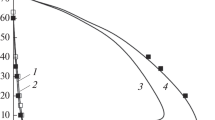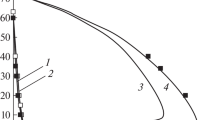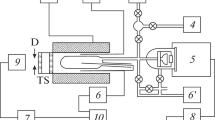Abstract
THE “chemi-ionization” which occurs when organic compounds are burned, either alone or mixed with hydrogen, in oxygen or air has received much attention. Data obtained by means of the flame ionization detector used in gas chromatographic work1–4, and studies of ionization in flames at reduced pressure5, show that when a variety (and sufficiently large number) of organic compounds is examined, certain regularities of behaviour become apparent. First, when traces of such a compound are introduced into a hydrogen/oxygen/ nitrogen flame, the number of free electrons produced is proportional to the concentration of the compound in the flame gases. Secondly, for equimolar concentrations of compounds which are members of the same homologous series, the number of electrons varies linearly with the number of carbon atoms in the molecule. Thirdly, when the compound contains C == C or C ≡ C bonds5, the number of electrons is increased with respect to the corresponding paraffin, and reduced when it contains oxygen.
Similar content being viewed by others
References
McWilliam, I. G., J. Chromatog., 6, 110 (1961).
Dewar, R. A., J. Chromatog., 6, 312 (1961).
Ettre, L. S., J. Chromatog., 8, 525 (1962).
Perkins, G., jun., Rouayheb, G. M., Lively, L. D., and Hamilton, W. C., Gas Chromatography, Third Intern. Symp., 1961 (Academic Press Inc., New York, 1962).
Bulewicz, E. M., and Padley, P. J., Ninth Intern. Symp. Combustion, 1962 (Academic Press Inc., New York, 1963).
Green, J. A., and Sugden, T. M., Ninth Intern. Symp. Combustion, 1962 (Academic Press Inc., New York, 1963).
Calcote, H. F., Twenty-sixth AGARD Propulsion and Energetics Panel Meeting (Pisa, 1965).
Calcote, H. F., Combustion and Flame, 1, 385 (1957).
Sternberg, J. C., Gallaway, W. S., and Jones, D. T. L., Gas Chromatography, Third Intern. Symp., 1961 (Academic Press Inc., New York, 1962).
Lewis, B., and von Elbe, G., Combustion, Flames and Explosions of Gases, second ed. (Academic Press Inc., New York, 1961).
Handbook of Physics and Chemistry, forty-third ed. (Chemical Rubber Co. Inc., Cleveland, Ohio, 1961).
Author information
Authors and Affiliations
Rights and permissions
About this article
Cite this article
BULEWICZ, E. Correlation between Chemi-ionization in Flames containing Organic Fuels and the Heat of Oxidation of the Carbon in the Fuel Molecule. Nature 211, 961–963 (1966). https://doi.org/10.1038/211961a0
Issue Date:
DOI: https://doi.org/10.1038/211961a0
- Springer Nature Limited
This article is cited by
-
Thermal and chemical ionization in flames
Combustion, Explosion, and Shock Waves (1970)





